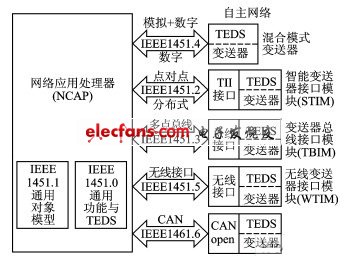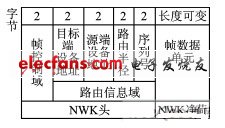introduction
With the development of computer technology and communication technology, distributed measurement and control systems based on various field standards are widely used. These systems use a variety of control buses, such as CAN, LONWORKS, FROFIBUS, HATR, FF, etc. These different bus standards have their own protocol formats, which are not compatible with each other, which brings a lot of inconvenience to the expansion of the system.
In view of this, the International Institute of Electrical and Electronics Engineers (IEEE) and the National Institute of Standards and Technology (NIST) jointly launched the IEEE1451 standard, which solves the bus interface compatibility problems of various standards and improves the interchangeability of products from various manufacturers. Interoperability.
1 IEEE1451 protocol
The IEEE1451 standard introduced by IEEE and NIST solves the compatibility problem between different networks by defining a set of common communication interfaces, and finally realizes the interchange and interoperation of products of various manufacturers. Its protocol cluster architecture and relationship are shown in Figure 1. According to the IEEE1451 standard, network smart sensors are divided into two major modules.

Figure 1 The overall architecture of IEEE1451 protocol
(1) NCAP (Network Application Processor) module
This module mainly performs network communication, TIM communication, data conversion and other functions. The IEEE1451.1 standard defines its physical model. NCAP is the interface between the standard transmitter bus and the dedicated network bus. This part is integrated with the microprocessor and plays the role of "brain" in the networked sensor. NCAP also supports hot swapping.
(2) TIM (Intelligent Transmitter) module
According to the way of connecting with NCAP, there can be many different functions of TIM. A TIM can support a single or multiple different channels, it can be connected to both sensors and actuators.
â‘ IEEE1451.0: This layer of standards includes general functions, communication protocols, and spreadsheets (TEDS FORMATS). IEEE1451.0 provides common and simple standards for different physical layers by defining basic command settings and communication protocol interfaces, thereby enhancing interoperability between these standards.
â‘¡ IEEE1451.1: According to the existing various network technologies, a standard connection method from smart transmitter to network is defined, and a standard object model is defined for the networked smart transmitter using object-oriented thinking. And define the software interface for each class of the model.
â‘¢ IEEE1451.2: A digital interface TII that defines the connection between the sensor and the microprocessor. It defines electronic data tables and data formats, and also defines a series of read and write commands, including reading and writing electronic data tables, reading sensor data, and setting actuator data.
â‘£ IEEE1451.3: Including the definition of distributed multi-point system digital communication and TEDS format, mainly used for synchronous data collection and communication of point-to-multipoint distributed intelligent sensor system.
⑤ IEEE1451.4: Contains the definition of mixed mode communication protocol and TEDS format. It is mainly aimed at the existing analog transmitter communication protocol. On the one hand, it supports the reading and writing of TEDS data by the digital interface, and on the other hand, it supports the measurement of field instruments by the analog interface.
â‘¥ IEEE1451.5: Define the wireless communication interface of the smart sensor, and communicate with the NCAP in the wireless transmitter interface module (WTIM) through the specified wireless communication protocol. Currently supports WiFi, Bluetooth, ZigBee protocols. IEEE1451.5 also defines TEDS related to wireless communication protocols.
2 Wireless communication protocol
The IEEE1451.5 standard provides a unified interface for wireless sensors using different communication protocols. Instead of developing a new wireless communication technology, it uses the mature wireless communication technology as the interface standard. The IEEE 1451.1 standard proposes three wireless communication methods: WiFi, Bluetooth, and ZigBee. In this paper, the ZigBee protocol is used, which mainly includes the PHY layer and MAC layer of IEEE 802.15.4, as well as the NWK layer and APS layer of ZigBee.
2.1 PHY layer of IEEE 802.15.4
The PHY layer uses DSSS technology. Different carrier paths provide different transmission rates. 2.4 GHz provides a transmission rate of 250 kbps. The PHY layer is used to provide transparent bit stream transmission between two devices. Its main functions include: channel selection and channel energy detection, idle channel * estimation, wireless channel data transmission and reception, and link quality of received packets.
2.2 MAC layer of IEEE 802.15.4
The MAC layer is responsible for encapsulating the data packets sent from the NWK layer and sending them down to the PHY layer, decomposing the frames sent by the PHY layer, and sending the decomposed data packets up to the NWK layer.
The MAC layer provides two transmission modes: beacon and non-beacon. Among them, the beacon transmission mode broadcasts a beacon frame to the network at a certain time interval through the network coordinator, and all nodes in the network use the beacon frame as a synchronization signal to achieve synchronization of the entire network. The non-beacon transmission mode uses the CSMA / CA mechanism to avoid transmission collision.
The main function of the MAC layer is MPDU data processing. The frame format includes three parts: frame header, MAC payload and frame tail. The frame control field in the frame header provides related control information such as frame type, security enable, target address mode, and source address mode. The MAC payload field is valid data of the MAC layer, that is, NWK data packets. The frame tail is the 16-bit CRC check sequence of the frame header and the MAC frame payload field.
2.3 NWK layer of ZigBee protocol

Figure 2 NWK frame format
The ZigBee Alliance has formulated the NWK layer protocol on the basis of the PHY layer of the IEEE 802.15.4 standard. Its main functions include: network layer protocol data unit processing, networking management and routing functions. The NWK frame format is shown in Figure 2.
Our rack shelves are compatible with all 19" racks and cabinets to hold various IT, network and other equipment. The main different shelves are as follows:
1. Normal whole piece rack shelf
2. Disassembled rack shelf: the 2 side ears are separate from the holding board.
The features are as follows:
1st: New Disassembled Shelf allows you to assemble according to your different usage, and Lip can be upside / downside for meeting different functions.
2nd: Disassembled structure decreasing damage of ears in transit, the freight charge almost half than normal whole piece rack shelf.
3rd: Easy assembly
Cantilever Shelf,Cantilever Wall Shelf,Cantilever Server Shelf,Network Cabinet Shelf
Ningbo JingCheng Communication Equipment Co., Ltd. , https://www.jingchengtel.com
